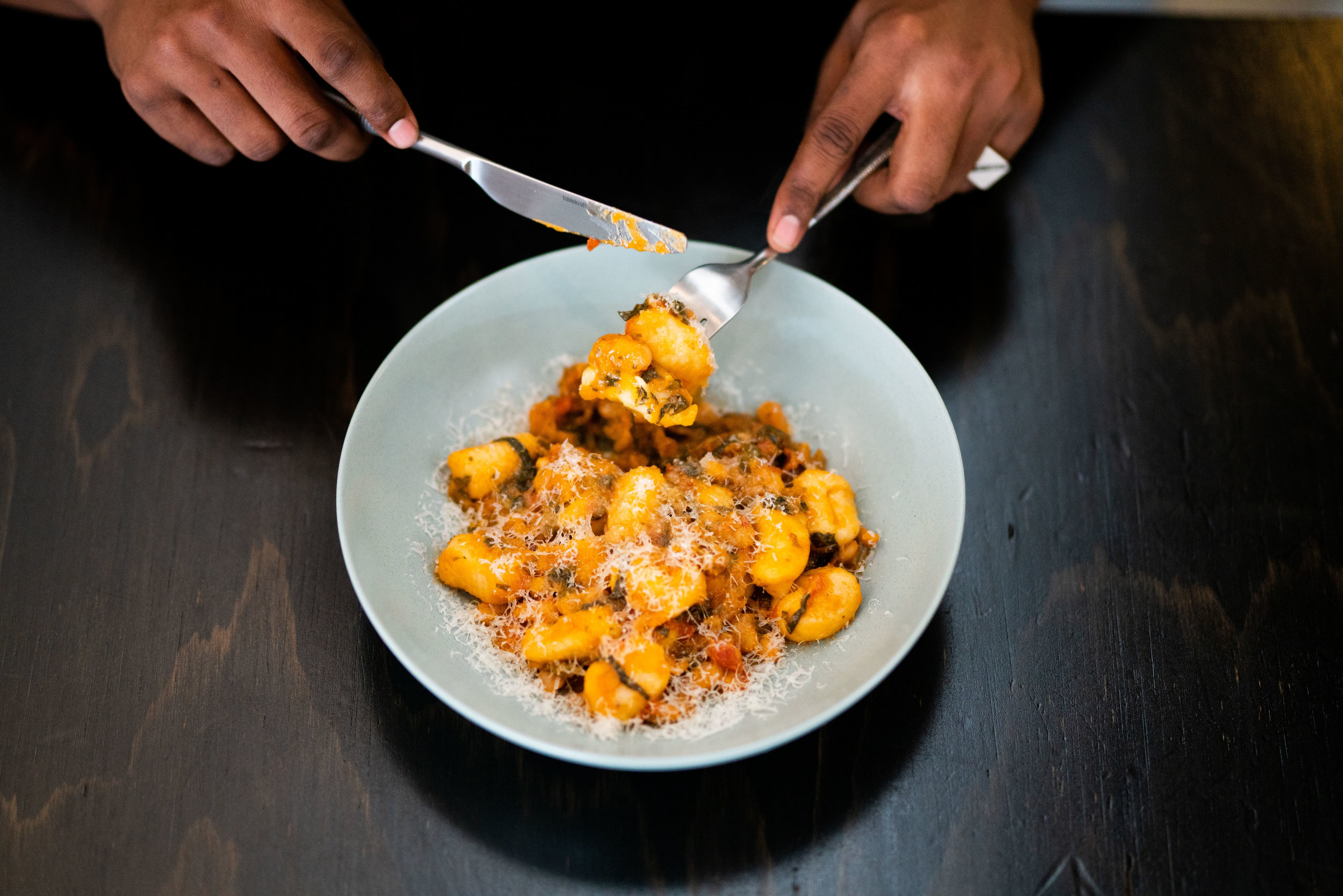Our head chef Frankie Dawson is one creative cookie. She’s cooked multiple cuisines in various London restaurants, including the top Middle Eastern venue The Barbary.
Frankie brings this wealth of experience to Bivouac. We’re lucky to have a chef who researches the origins of food and recreates these yummy dishes to share with the people of Perth.
With a new menu on the table, we spoke to Frankie about her experience as a chef and Bivouac's new menu.
Tell us about your journey as a chef? What’s been some of the highlights of your career?
I think being offered the head chef job here at Bivouac is a highlight for me. I had been hungry for my own kitchen for a while, but had been waiting for the right opportunity. I get a lot of creative freedom here, which is what all chefs want at the end of the day.
Your cooking has spanned many cuisines. What are your favourites to cook?
My mum is Anglo-Indian, so Indian has to be my favourite by a long shot. I grew up eating a lot of curry and watching my Grandma make Indian sweets and curry puffs. She would tell me stories about going to school with a tiffin carrier of curry and chapattis, and smuggling her pet monkey into class. So I was fascinated with the country from early on.
Each time I go to visit, I keep a diary of absolutely everything I eat, and am always referring back to that for flavour ideas and inspiration. I love Mughal style which was the regal cooking during the Persian rule. This includes dishes such as kofte, shish, raita, biryani and flatbreads. At The Barbary, I learned about Middle Eastern food, and realised how much crossover there was with Indian recipes. That opened up a whole new world for me.
What’s the best part of working at Bivouac?
It has to be the team for sure. The kitchen and front of house team all work well together and have a lot of fun. Front of house have been really open to my ideas. It’s great to have a team who want to be part of the journey of discovering new ingredients and introducing them to our customers. There’s a team of strong independent women at Bivs. We’re all really supportive of each other and that forms a great bond. It doesn’t happen very often, but when it does its pretty magic.
You’re also an artist. How do you weave your other creative processes into your cooking?
Haha. I’ve not been doing much drawing recently! I started a degree in printed textiles and one in illustration, but didn’t finish either. I was working in hospitality to support my studies until I realised hospo was where I belonged. I apply a lot of the skills I learnt studying art and design to kitchen work. You have to have self discipline for both and be prepared to immerse yourself in an idea or project. Studying design, you put a lot of research and experiments into a project. This is how I approach food. I throw myself into researching a culture or cuisine because I want to honour the traditions and techniques whilst putting my own spin on things.
You’ve just launched a new menu at Bivouac. Can you walk us through some of the dishes?
I’ve kept some of the favourites but given them a twist for the season change. There’s the inevitable return of the Cauliflower, which caused uproar when I took it off. Man, people go crazy for that vegetable! I’ve created a smoky, gluten-free Ajo Banco which sort of reminds me of a Vegan Taramasalata. It pairs really well with the sweet peppery vinaigrette that we douse the crispy cauliflower in.
Everyone is loving the Goat Nuggets. We also have a main of Slow Braised Goat Shoulders, shredded with herbs, spices, shallots and braising liquor before shaping and crumbing. It’s served with a Tunisian style Caponata.
The Palestinian Chicken is now served with some beautifully preserved lemon leeks and a rustic, skin-on babaganoush. I try to minimise wastage wherever possible, so if there’s part of a vegetable that’s edible and tasty, there’s no way that’s going in the bin. We put so much love into these chickens. They’re poached in master stock before drying out the skin for two days. We make a Palestinian 9-spice which we fold into butter and roast the chickens in.
We love the sound of Maakroun white bean, silverbeet & tomato sugo, pecorino. It sounds delicious! Can you explain what it is?
So Maakroun is a pasta dumpling dish found in the mountain villages of Lebanon. It’s similar to gnocchi, and usually served very simply with garlic and olive oil. We’re serving ours with a ragu style sauce with Greek flavours. There are many versions of Maakroun over the Middle East, most of which are sweet biscuits or ‘Arabic’ – watch this space!
What’s your process when creating new dishes?
Hmm, it really depends on what’s caught my eye at the time. Sometimes I’ll start with one ingredient I want to use, and think about pairings, layers of flavour and textures. Other times, it will be a specific recipe or dish I want to play around with. I don’t really have a set process other than pages of notes that would look like gobbledygook to anyone else! I also have a library of cookbooks I refer to for inspiration. When I’m designing menus, my apartment will be sprawled with books opened and bookmarked at different pages.
As you can see, we’re so lucky to have Frankie Dawson as head chef at Biv! Check out our new Winter menu here.





